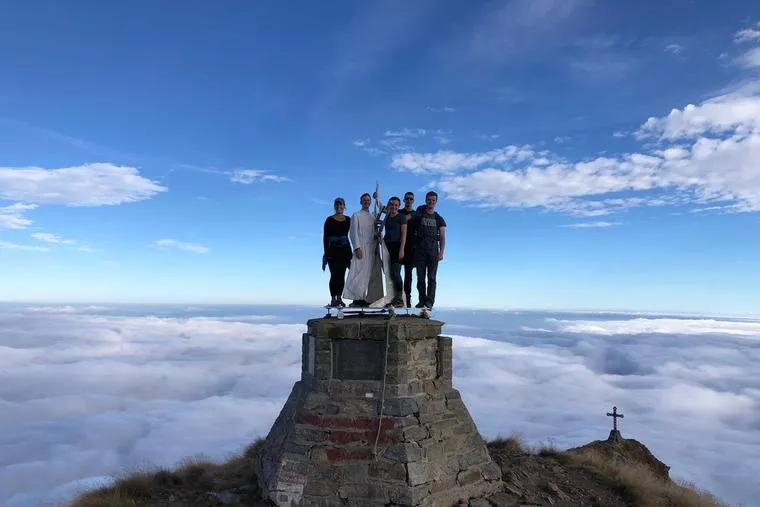
Nearly a century after the death of Pier Giorgio Frassati, I set out with friends to hike in his footsteps in northern Italy, hoping to glimpse something of the holiness that marked his ordinary yet extraordinary life.
SIGN UP FOR OUR NEWSLETTER HERE
MONTE MUCRONE, Italy — High above the Italian town of Biella, Monte Mucrone rises 7,661 feet into the sky, its rugged trails and sweeping views once familiar to St. Pier Giorgio Frassati, the “Man of the Eight Beatitudes,” as St. John Paul II famously named him.
From its heights, the clouds below resemble a calm sea, and beyond them the sun sinks, casting its last golden light across the illusory horizon.

At least that is the view that left the most lasting impression on me. And just as it was for me, I believe it would be evident for anyone standing at that top why the mountains were one of Pier Giorgio’s favorite places to be.
Even without climbing, one only has to read Pier Giorgio’s letters — carefully assembled by his sister Luciana over the years following his passing — and look at the few existing pictures of the young man’s life to see that love and youthful passion clearly shine through.
It is no wonder that many associate the young saint with his famous words “To the heights,” words that in many ways capture not only his love for the mountains, but his recognition of the beauty of creation and the greatness of the Creator.
I’ll admit, I have often felt frustrated by how much people seemed to spiritualize those three little words Pier Giorgio once scribbled on the corner of a photograph, Verso l’alto, as a pursuit of spiritual perfection and closeness to God and a constant exhortation to strive ever higher toward God.

In my mind, he wrote them because he was simply a young man who loved climbing, sports and the fresh air of the mountains; and climbing was merely a passion, not the reflection of his quest for holiness.
It wasn’t until I hiked Monte Mucrone myself with my own friends — and took the time to read his letters — that I began to see those three words in a different light and understand the holiness of his brief but intense life in a new and deeper way.
‘The Most Beautiful Thing I’d Ever Seen’
Together with students from Franciscan University of Steubenville studying abroad, led by Dominican Father Gregory Pine, my friends from the Pontifical University of St. Thomas Aquinas in Rome and I started our pilgrimage in Turin, where we began with Holy Mass at the cathedral and prayers at the tomb of then-Blessed Pier Giorgio Frassati, before continuing to the Sanctuary of Our Lady of Oropa.
From there, we made our way to Villa Ametis, the home of Pier Giorgio’s grandparents in Pollone. There, his 95-year-old niece, Wanda Gawronska, warmly guided us through the rooms where Pier Giorgio once played, studied and spent time with family and friends.
Through the window in his room, still filled with personal belongings, the peak of Monte Mucrone could be seen rising in the distance — the same view that once lifted his eyes heavenward. Now, it was ours to climb.

Among my friends, Nobertine Father Lazarus McDonald from St. Michael’s Abbey in California, recalled the adventure as both “difficult” and “humbling.”
“I remember the morning we began the climb up Mount Mucrone, it was chilly and damp,” he recalled. “Thick clouds obscured the peak and allowed me the delusion of thinking that it would be an easy climb. It wasn’t.”
The thick fog surrounded us for what seemed like hours. Urban Hannon, a seminarian for the Fraternity of St. Peter in Wigratzbad, Germany, described the breathtaking moment when we finally emerged from the gray landscape and a magnificent view unfolded before us.
“I remember walking through the gray fog,” Hannon said, “and that moment when Father Gregory, a few steps in front of me, just said, ‘Woah!’ and then three seconds later finding out why, when, finally, we pierced the top of the clouds and saw the glory above.”
“That day is always what I answer when people ask for my best memory of my time in Italy,” Hannon added. “It was the most beautiful thing I’d ever seen.”
Mary Stone, who grew up in the Pacific Northwest, had “hiked around beautiful mountains and gorgeous scenery” for most of her life. Yet, she said that hiking Mucrone was, without a doubt, one of “the most exhilarating and rewarding peaks” she had ever hiked.

“When we reached the rock scramble at the end, we were truly standing above the clouds,” Stone continued. “I couldn’t even see the bottom of the mountain or the path that had seemed so long and unending. We were standing above a sea of clouds and had left everything else behind. The only sights in view were the peak and the cross at the top.”
The Gift and Strength of Companionship
After hours of climbing, hauling ourselves up by ropes on the steep slopes, drinking from rocky mountain springs from our hands and on our knees when our bottles ran dry, and scrambling on all fours over the final rocks, we finally reached the summit.
Marked by a stone-paved obelisk and a towering cross, we had arrived at the place so dear to the heart of Pier Giorgio, the peak he would gaze upon from his room in his family’s summer home in Pollone, and where, as his letters attest, he attended Holy Mass in 1920 at the age of 19.
“I won’t say that the view at the top or the sense of achievement at having accomplished something difficult was worth it, despite the challenge. The challenge itself is what made the accomplishment so sweet,” Father Lazarus explained, emphasizing that “[I] wouldn’t have enjoyed the view from the top nearly as much if [I] hadn’t had to work so hard to attain it.”

Just as Pier Giorgio deeply valued friendship and surrounded himself with close friends with whom he shared both faith and adventures, so our hike was truly marked by companionship.
In fact, Father Lazarus said, “Friendship spurs us on to do great and difficult things. And that's why I have such fond memories of that trek, not just because I overcame bodily weakness and did something hard, not just because of the spectacular view, but because of those I shared the journey with.”
Seeing Through Pier Giorgio’s Eyes
It was a blessing to see what a saint saw.
“For me to grow close to a saint, I have to literally put myself in the place where that person was,” Stone shared, saying that since she doesn’t have “a strong imagination,” places and experiences help make their lives real to her.
“If I want to know a saint, regardless of whether that person lived a millennium ago or a century ago, I go to that place, take in the surroundings, and experience it though my senses. When that happens, the saint usually becomes one of my best friends and biggest allies on the journey in life.”

In a similar way, Father Lazarus shared that visiting the Frassati family home and hiking the same mountain trails as Pier Giorgio made him feel as though he “was experiencing some of those same things that had shaped him and made him into the man that he was.”
“In climbing Mount Mucrone, it seemed evident to me that Pier Giorgio was a man of great energy, strength and love for all that is beautiful and fresh.”
“There is nothing quite like arriving at a mountain peak,” he added, “and looking down upon a sea of clouds that can turn the mind to the immensity and beauty of God, from whom all goodness comes.”
Discoveries Along the Way
My friend Isaac Cassidy was struck first and foremost by “the catholicity of Pier Giorgio’s life” and how “his faith filled and fulfilled every facet of the circumstances Providence had placed him in.”
The saint was the son of a politician, and “he sanctified his dedication to society's good”; while he loved the mountains, “he saw them in and through God’s overwhelming grandeur”; while he loved his friends, “he loved them with the sacrificial love which can only be understood in Christ.”
“This is why he is a saint for our difficult times,” Cassidy observed. “His faith was not pigeon-holed; it didn’t coexist with a society inimical to it or occupy a time slot in his busy life. No, his faith was everything to him and filled every activity. He made room everywhere for grace to perfect his daring, adventurous spirit.”

Father Lazarus further explained: “It seems to me that the character of Pier Giorgio is a reflection of that rugged and beautiful place, for he was a man of great discipline and firmness as well as a man of great generosity and love. He was a man who delighted in the simple joys of creation, and he delighted in drawing others to their Creator.”
None of us was left untouched. I think I can confidently say, in the words of Mary Stone, that “having the chance to visit Oropa and hike Mount Mucrone made me confident that Pier Giorgio is a person I now know personally, who wants to intercede for me and accompany me on my own hike to heaven.”
Verso l’Alto and the Pursuit of Holiness
Pier Giorgio was not just a cheerful mountaineer — though his letters reveal a profound love for his family, his friends and his faith, and an almost magnetic attraction to the mountains.
In fact, apart from his studies — which he regarded as his primary duty to family and society — and his commitment to charitable and Catholic student life, he devoted an extraordinary amount of time to the mountains. Even as he lamented the endless hours of study and the exams that weighed heavily on him, his letters show that the mountains lifted him above his earthly concerns.
Climbing Mount Mucrone in the footsteps of Pier Giorgio with my friends, I was able to glimpse some of that mysterious force.

Among the many lessons revealed to us: the importance of deep and meaningful friendships, the beauty of creation as a reflection of God’s majesty, the fragility of life and the need to live it to the fullest, the balance between study, work and play — and the necessity of enjoying that play — and the ability to let faith guide everything you do.
Pier Giorgio’s love of the mountains formed a vital part of his life and reflected, in some way, his pursuit of the good — and his pursuit of holiness.
Discover more about the life of Pier Giorgio Frassati
This article was originally published on NCRegister.

Bénédicte Cedergren is an Associate Producer for EWTN News Nightly. She is Swedish-French and grew up in Stockholm. After graduating from the University of Stockholm with a degree in Journalism, Bénédicte moved to Rome where she earned a degree in Philosophy at the Pontifical University of Saint Thomas Aquinas. She also sings sacred music and works as a photographer. Passionate about spreading the truth and beauty of the Catholic faith, Bénédicte enjoys sharing the testimonies of others and writing stories that captivate and inspire.







